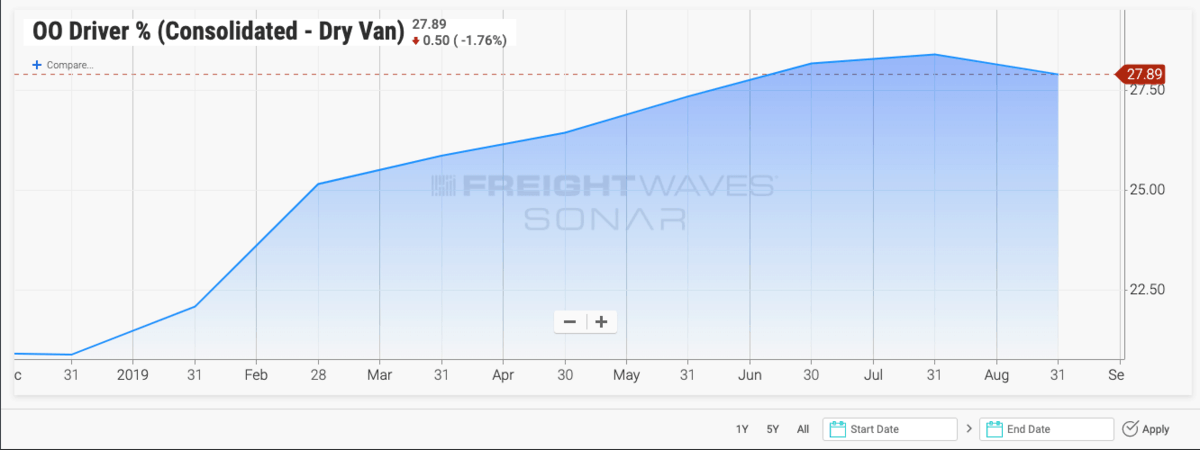Motor carriers and third-party logistics companies see California’s new law on employee classification as universally negative for intermodal trucking, forcing further costs on an industry running on thin margins.
Even so, carriers are still being advised to not yet change their business model until challenges to the law get their day in court.
After being signed this week by California’s governor, Assembly Bill 5 (AB5) becomes law next year. AB5 codifies the California Supreme Court decision rendered in the 2018 Dynamex case that employers can only classify a worker as an independent contractor after a three-part test. Otherwise, workers must be classified as full-time employees, forcing the attendant costs of payroll taxes and other benefits on the carriers.
Moving contractors to company drivers is certain to raise costs significantly throughout the supply chain, said Robert Lilja, chief operating officer of California-based Weber Logistics.
AB5’s impact is particularly acute for port trucking. The Harbor Trucking Association, which represents carriers and drivers in the region, estimates about 80% of the 16,000 trucks that call on the local ports are independent, either working under their own operating authority or another’s.
As local carriers discussed AB5 with their drivers, “the drivers were really upset,” said Weston LaBar, chief executive officer of the Harbor Trucking Association. “Many of these drivers don’t want to be employees.”
Weber Logistics uses company drivers handle most of its freight. But the company may tap smaller, power-only carriers for seasonal peak volumes, and those carriers may themselves use some owner-operators. Lilja says the new law favors further consolidation in the industry and larger intermodal carriers.
“Anytime that I need a partner for a seasonal peak, it is going to cost me more,” Lilja said. “My belief is that many of those companies will shrink or go out of business.”
“There’s no question that this will drive rates upward,” he added. “Carriers will downsize or leave the market. I wouldn’t be surprised if drayage rates are up 25% in a year from now.”
In addition to buying company trucks for employee drivers to replace the owner-operator’s truck, it can cost anywhere from $5,000 to $10,000 to recruit and retain drivers, said John Larkin, partner at private equity firm Clarendon Group. Those costs compound due to the high turnover in trucking.
Speaking at the Intermodal Association of North America annual meeting, Larkin said AB5 runs counter to the increasing popular business model founded on flexible worker capacity. As such, the law means, “Investors are going to take a pause to see how this legislation is interpreted,” he said.

One route for allowing independent contractors to continue working would be for them to get federal operating authority to carry freight and to incorporate as a business. Carriers likewise could get brokerage authority to handle overflow freight.
Yet neither of those really help the economics of drayage, Lilja said, as incorporated drivers with operating authority would have to buy insurance, but lack the volume discount and negotiating power of a large carrier.
But it is not clear yet whether those models will be allowed under AB5. The risk for California carriers is the challenge from regulators.
“Just know that anything creative is going to be tested in court,” said Shawn Yadon, chief executive officer of the California Trucking Association.
Despite AB5’s passage, trucking companies should not lose hope for its being modified, HTA’s LaBar said.
He said California lawmakers may take up a separate bill that addresses trucking specifically, either in the current session or the next session.
Uber, Lyft and DoorDash pledge $90 million to support a ballot measure to defeat AB5. LaBar said the state’s trucking groups are also likely to file an injunction against the bill, citing federal preemption due to interstate commerce.
On the flipside, the HTA has its own program, Trucker Advantage, to help independent drivers to incorporate and to get operating authority, along with affordable insurance and other volume discounts.
Even so, the challenges mean that carriers and drivers serving the market should not react immediately, LaBar said, lest they give up the right to use independent
“If you go all employee drivers and were found to be federally preempted, you can’t go back and reclassify those drivers,” LaBar said. “You are voluntarily giving up the right to use independent contractors in the future.”










